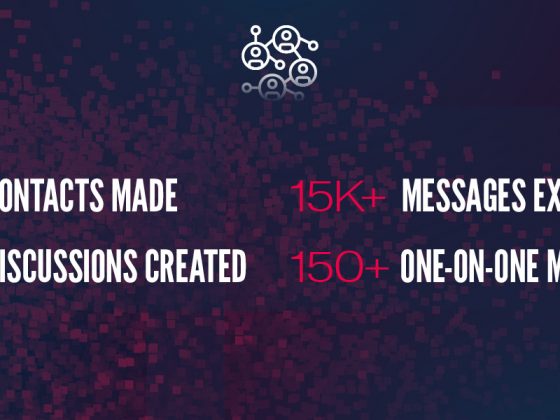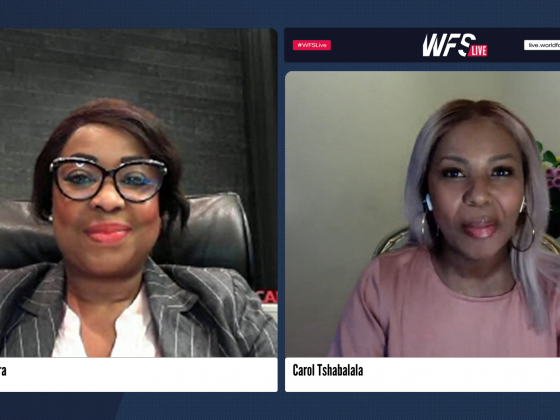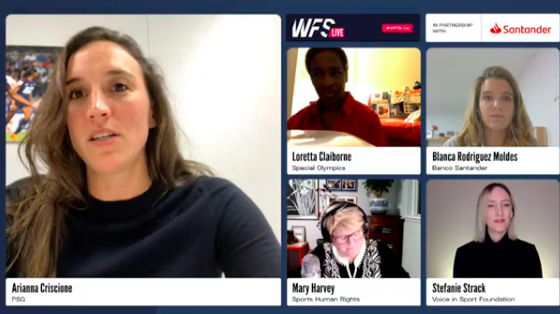“SOCIAL MEDIA IS GOOD, BUT ACTIONS ARE MORE IMPORTANT”
Lisa Zimouche – Freestyle footballer
“Authenticity is important, being genuine. If you support something, if you want to speak about a social issue, it has to be authentic because people will feel it. And action is very important. Being on Instagram, Twitter and Facebook is important, having a platform to speak is important, but action to me means more than just words. Social media is good, but action is even more important.”
🗣️ "I think the challenge right now is that so many young people want to speak, they want to act but they don’t know how to do it. We have to be educated more on so many topics to speak or to act but I think we’re on a good path."
– @Lisafreestyle #WFSLive pic.twitter.com/v2WyXPtGam
— World Football Summit (@WFSummit) November 24, 2020
“THERE IS A HUGE OPPORTUNITY TO INCREASE THE MONEY FANS SPEND ON MATCH-DAY”
Maheta Molango – Principal, 3MS Consulting
“I think there is a huge opportunity in Europe in terms of increasing the amount of money fans spend on match-day. There is a huge gap between what fans spend here in Europe and what they do in the US. For me, the starting point is that if I want them to spend more money, I need to know much more about them. The digital, today, allows you to know who they are, the preferences they have, how they behave.”
Alon Werber from @Pixellotltd takes us through how they are changing the game when it comes to video analysis in football. pic.twitter.com/wFLZIDoQHJ
— World Football Summit (@WFSummit) November 24, 2020
“FC BARCELONA GENERATES MORE THAN 120 TERAS OF ESSENTIAL VIDEO CONTENT EVERY YEAR”
Imanol Eguskiza – Innovation Manager, FC Barcelona
“FC Barcelona is generating more than 120 Teras of essential video data every year. For the last four years, Pixellot has been supplying us with top level technology enabling us not only to centralize and manage all the video content, avoiding any loss of such a huge amount of data, but also automatically triggering 16 unattended recording camera systems that we have deployed in all our fields. These systems are capturing every day all the games from the first football team to the youngest academy teams and the various sport sections.”
“NEARLY 40% OF GEN Z’S SAY THEY ARE INFLUENCED BY SOCIAL MEDIA IN THEIR PURCHASES”
Justin Toman – Head of Sports Marketing, PepsiCo
“Nearly 40% of Gen Z’s are influenced by social media in their purchases, that’s what’s truly driving the decisions and the eyeballs of these consumers. We are pivoting all our marketing initiatives to make sure we are accounting for that and really making that a focal point. Any campaign or any platform we do we start planning them by saying ‘how is this going to be consumed digitally? How can we bring consumers and fans closer to this great event that not everybody can come to, but how can we reach millions of people by giving them digital content?”
“SPONSORS ARE ASKING FOR VALUES”
Ramón Alarcón – CBO, Real Betis
“You can buy advertising wherever you want, but in an institution like Real Betis, with a lot of engagement and a lot of loyalty, we have to generate engagement with some values that create a link between us and the community… Some years ago, sponsors were asking for digital assets, but now they are asking for values, to create a story.”
“THE FUTURE OF BROADCASTING WILL BE FUELED BY LIVE GAMBLING”
Juan Carlos Rodríguez – President of Sports, Univision
“Data will be the core engine of growth in the future. If you take into account the capability to personalize the broadcast, plus the zero-latency of the 5G, plus the data generated by companies like Driblab and by the audience, you can create a new business that is live gambling during the games. The future of the growth broadcasting and the value of rights and players will be fueled by this new revenue stream.”
“INTERNATIONAL FOOTBALL IS THE REAL WEAKNESS OF THE CURRENT CALENDAR”
Peter Hutton – Director, Sports Partnerships, Facebook
“One of the things that I find really frustrating with the football calendar at the moment is the interruption of the leagues’ season for the international weekend, which doesn’t feel meaningful… Putting all the International football together in the summer, as the World Cup does perfectly, is a great way of building a story, of having something that sponsors and broadcasters can get behind. The current model where you drop in a couple of games is the real weakness of the current calendar. I love international football, but it’s got to have context and a story, and it doesn’t feel like it has on international weekends.”
🗣️ "There needs to be less time between World Cups if you are to stay relevant with the new generation."
– @LuisDV (@ElevenSportsHQ)#WFSLive pic.twitter.com/jhdo9n8eUW
— World Football Summit (@WFSummit) November 24, 2020
“WOMEN’S FOOTBALL WILL BE ONE OF THE BIGGEST SPORTS THAT THE WORLD HAS EVER SEEN”
Luis Vicente – Group CEO, Eleven Sports
“Today you have a massive amount of young girls choosing football as their preferred sport, and one of the things they like is that it has a much more open environment than the men’s version of the game. That’s definitely a massive opportunity. Commercial partners, broadcasters, all the big weaponry that made the men’s game what it is, is very interested in supporting women’s football. If we have the right strategy, this will be one of the biggest sports that the world has ever seen in the years to come.”
🗣️ "We’ve been impacted heavily financially by covid and Leeds as a city has been waiting years to be back in the Premier League but we haven’t been able to celebrate it with our fans."
– @andrearadri (@LUFC)#WFSLive pic.twitter.com/9vFvyUMISH
— World Football Summit (@WFSummit) November 24, 2020
“DATA AND CONTENT WILL LEAD US INTO THE NEXT DECADE”
Scott O’Neil – CEO, Harris Blitzer Sports & Entertainment
“As we think about how we build for the future, we need to focus on data and content. Those are the two keys that will lead us into the next decade or so. You can add on a third leg of that stool, which is what we call ‘data seen direct-to-consumer’ and the capability to actually find new consumers. We as a sports industry, in particular the team space, we need to get a lot better, a lot quicker.”
“WE NEED TO REALLY DISRUPT THE DISTRIBUTION MODEL”
Andrea Radrizzani – Founder and Chairman, Aser Ventures
“I strongly believe that, on the sports side, distribution, at the moment with the traditional pay TV, is not matching the demand and the opportunity that technology gives to reach community, to reach niche, to reach a bigger audience, to reach people at different prices and different power consumptions. We need to redesign the distribution model that has been active and been around for 20 years, because now I think we are missing opportunities to create more various rights holders”.


